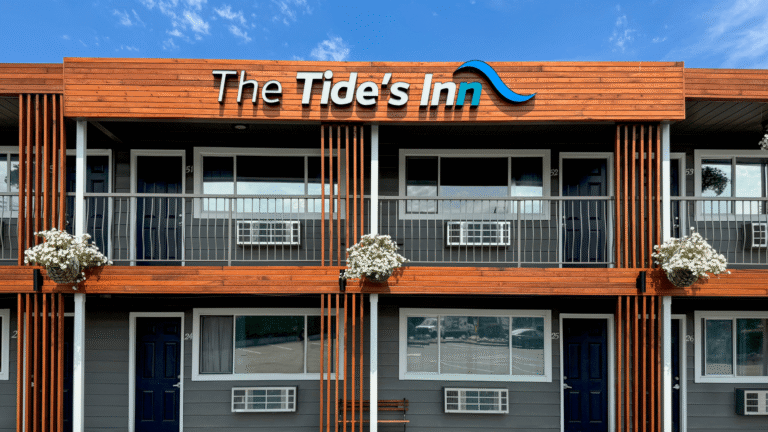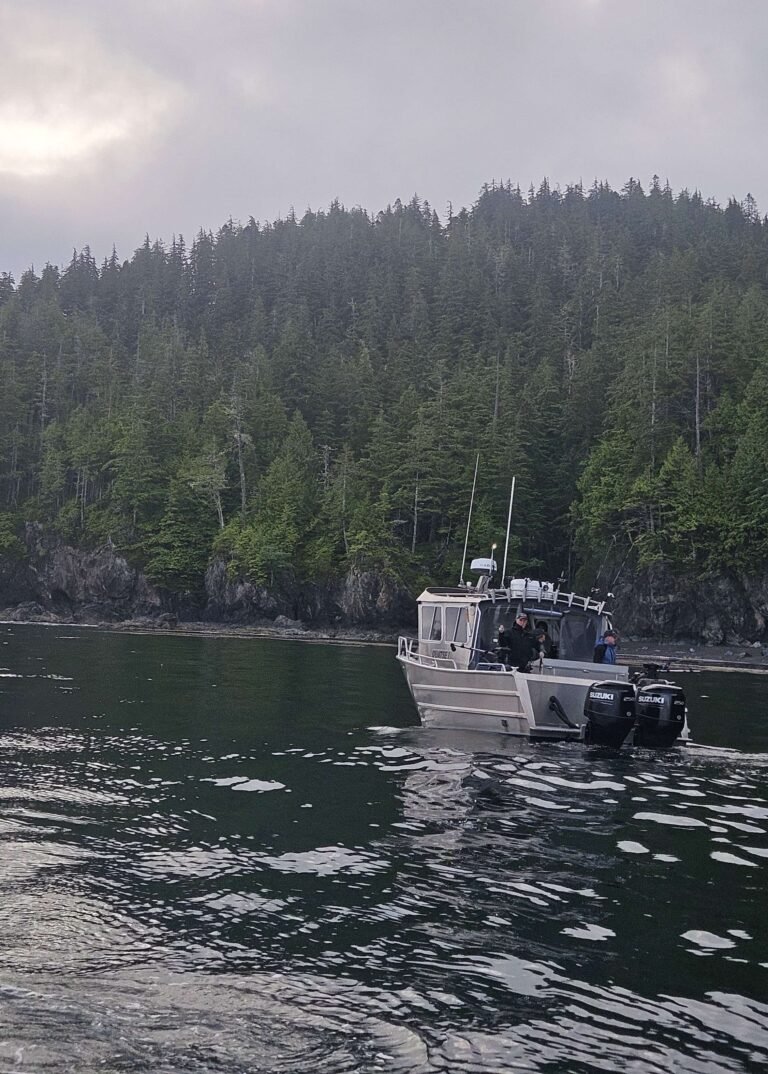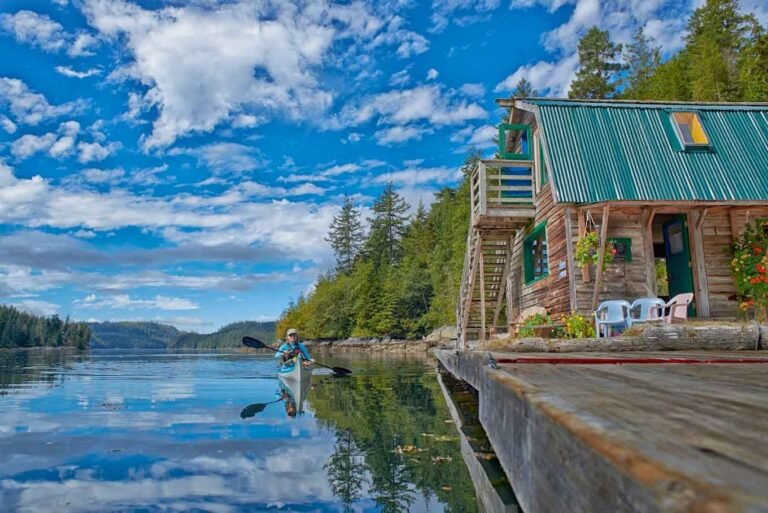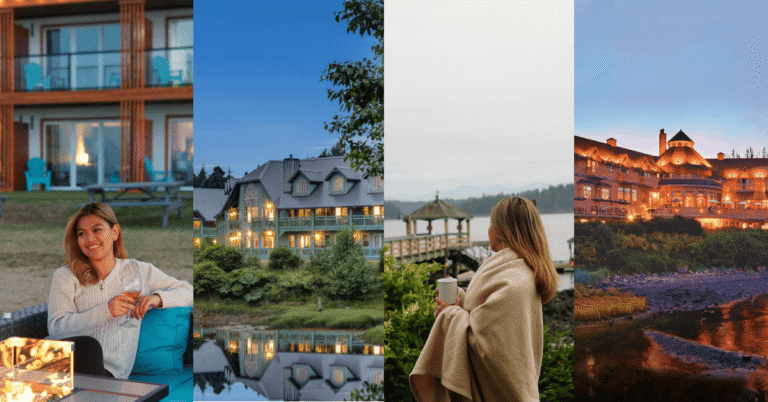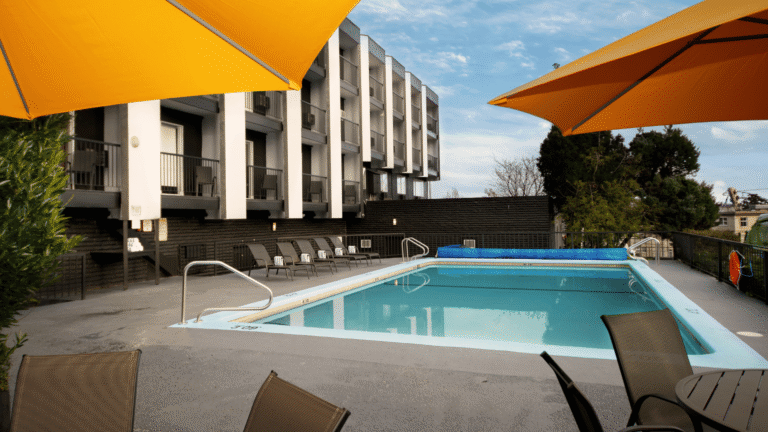Approximately 250 air miles northwest of Vancouver, and 80 miles (130 km) north of Port Hardy, are Hakai Pass and the Hakai Luxvbalis Conservancy Area, British Columbia’s largest marine park, and one of the better-known paddling areas on the west coast.
This area encompasses a large archipelago of outstanding natural beauty and recreational value. From fully exposed shorelines to rolling, forested hills and 3,000-foot (1000-m) peaks, Hakai offers some of the most varied and scenic coastline in the province.
Special features such as lagoons and reversing tidal rapids, beaches, all-weather anchorages, tombolos, and an intricate network of coves, inlets, and channels make it an ideal area for boaters, anglers, scuba divers, naturalists – and experienced sea kayakers.
There are some places, luckily, that are still inaccessible by road, and British Columbia’s Central Coast is one of them. Until BC Ferries launched its Discovery Coast Passage run in the summer of 1996, the Central Coast was also largely inaccessible by water. Now, to the delight of adventurers and locals alike, from June to September the Queen of Chilliwack connects the community of Port Hardy, at the northeastern end of Vancouver Island, with Bella Coola, at the head of the North Bentinck Arm, making regular stops along the way. Visitors wishing to explore this remote wilderness can access it by sea or by air. The Queen of Chilliwack stops at Namu, the closest settlement.
Hakai is located across Fitz Hugh Sound from Namu, a busy shipping route also frequented by Pacific white-sided dolphin. Fuel and groceries are available at Bella Bella, Namu, and Dawsons Landing (Rivers Inlet). Private or chartered boats can be arranged from Vancouver, Port Hardy, and Bella Coola. Chartered and scheduled flights are available from Vancouver, Port Hardy, Bella Bella, and Bella Coola.
Hakai Pass in the Hakai Luxvbalis Conservancy Area is world-famous for its unsurpassed salmon fishing. For thousands of years, huge runs of chinook (king) salmon, coho (silver) salmon as well as Sockeye, Chum and Pink salmon crowd through Hakai Pass from the open Pacific Ocean headed for the rivers and streams where their life began. Besides salmon, there’s good fishing here for halibut, lingcod, red snapper and rockfish. The area has a number of commercial floating fish camps, and superb fishing resorts that offer a true wilderness experience amid spectacular scenery and abundant wildlife.
Many parts of the so-called Discovery Coast are relatively unknown to kayakers. It will appeal to resourceful paddlers who seek a sense of pioneering, which includes laying some groundwork, discovering new fishing spots, wildlife watching, dealing with unknown tidal currents, and finding new campsites.
When European explorers arrived along this coast in the 18th century, it was inhabited by Natives from several cultural groups. Although hunters and gatherers like the tribes of the Interior, the coastal natives, due to their abundant food supply, were able to establish permanent villages. Their complex cultures were distinguished by an emphasis on wealth, a refined artistic tradition, and a rich spirit life. Travel along the coast was accomplished via cedar dugout canoes that could be impressive in their length. Although there’s nothing more inspiring than to see one of these massive canoes in action, they are only brought out for ceremonial occasions, such as a paddle trip to Vancouver or the Olympic Peninsula in Washington. These days, aluminum-hulled, high-speed boats are the vessels of choice among all inhabitants of the coast.
Explorers from Russia, Britain, France, and Spain converged on this coastline in the last quarter of the 18th century, motivated by trade possibilities or – in the case of Spain – a desire to protect territorial waters. Two British explorers, Captain James Cook in 1778-79 and Captain George Vancouver in 1792-93, did the most systematic charting of the coast. After an international tussle, the British eventually gained control of what would later become the coast of British Columbia. Colonization and settlement began in the 19th century, although BC’s Central and Northern Coast is still not heavily populated. Logging, fishing, and tourism are the primary industries, though with the decline in stocks and automation in the forest, fewer people live here now than in previous decades. After a disastrous decline in Native populations (by as much as 90 percent in some nations) that began over a century ago due to infectious diseases such as smallpox and tuberculosis, today’s numbers match those of precontact times.
Location: Hakai Pass is located between Hunter Island and Calvert Island on the west coast of central BC, 250 air miles northwest of Vancouver, and 80 miles (130 km) north of Port Hardy.
One of the better areas to paddle within Hakai is Spider Anchorage, southeast of Spider Island, which consists of sheltered bays, white sand beaches, and a multitude of marine life. Another popular anchorage is Pruth Bay on the north side of Calvert Island, reached via Kwakshua Channel. The recreation area has no developed facilities and has wilderness campsites only. Freshwater is available at some beaches, but creeks dry up during summer, and visitors are advised to carry their own water supply.
Weather: Kayakers must be well prepared for poor weather and rough seas, which may occur at any time of the year. Fog can roll in very quickly, necessitating navigation by compass, and sea conditions can change from flat calm to 12- to 20-foot (4- to 6-m) seas within a matter of hours. The west coast of Calvert Island can be hazardous due to strong surf and should not be approached without knowledge of the locale, and then only under ideal conditions.
Winds during the summer are usually westerly or southwesterly, and on sunny days are often light or nil in the early morning, pick up midday to late afternoon, then die down in the evening. They can be extremely strong in the coastal inlets such as Burke Channel. Weather information can be picked up on VHF Channel 21B (161.65MHZ).
Canoeing & Kayaking: Paddlers can enjoy the many small straits, exposed coastline, and islands accessible from the communities of Bella Bella and Denny Island (Shearwater), such as the Goose Group in the western reaches of the Hakai Provincial Recreation Area. There is good camping on the south end of Campbell Island as you make you way through Hunter Channel towards Goose. Be prepared to paddle 5 miles (8 km) through the open water in Queens Sound between Campbell and Goose, the largest by far of the five islands gathered here. At the north end of Goose Island is a pure white beach composed largely of pulverized clam shells that when walked upon with bare feet emit a squeak not unlike the squeal of a sneaker on a gymnasium floor. This is truly an enchanted island. Note: There is no freshwater in the Goose Group.
Boating: Pleasure boaters have always appreciated the pristine beauty of the Central Coast; however, many have been reluctant to transit the open waters around Cape Caution, the only part of the Inside Passage not sheltered by offshore islands. Now boaters can bring their crafts by ferry to any of the coastal communities and launch from there.
Diving: The waters of the Hakai Provincial Recreation Area are among the finest in the world for underwater exploration, with exceptional viewing opportunities year-round. There are wrecks along virtually the entire Central Coast, making it a magnet for divers. Three good wrecks are just off Atli Point, near Shearwater on Denny Island, and Namu is particularly popular. Many charter dive tour operators are based on the Central Coast between June and September, with vessels outfitted with diving tanks and wet suits.
Other recreational activities in and around Hakai Pass include hiking and whale watching.
Wildlife: The midcoast is bald eagle country, and kayakers will also have the company of the ubiquitous kingfisher, common loon, cormorant, and sandpiper. In the Hakai Provincial Recreation Area, over 100 species of birds have been identified, ravens and ospreys among them. Feeding flocks of gulls, auklets, murres, and murrelets are numerous in the waters of Kildidt and Queens Sounds. Black oystercatchers, pelagic cormorants, surf birds, and both black and ruddy turnstones are also common.
Wildlife in British Columbia
Tidal Pools: The intertidal waters are home to an amazing number of marine life form, and their existence and activities are controlled by the rhythmic movements of the tides. Every tide pool has its own distinctive inhabitants: mollusca, crabs, starfish, anemones, sea urchins, and many others.
Marine mammals to watch for include harbour seals, sea lions, beavers, river otters, orcas, and humpback whales. Offshore waters are home to minke, gray, and humpback whales, as well as porpoises and dolphins.
Terrestrial wildlife includes black-tailed deer, mink, and wolves, as well as black, Kermode, and (on the mainland) the largest grizzly bears in the province. British Columbia is one of the richest wildlife viewing areas in Canada.
Those taking the Discovery Coast Passage by ferry should be aware that, depending on their departure time and length of trip, they may have to ‘camp’ one night aboard ship. A sleeping bag or warm blanket will enhance your comfort in one of the reclining seats. Alternatively, bring along a camping mattress and stretch out on the floor. A small number of cots and blankets are available onboard. Hardy types are also permitted to pitch their (self-supporting) tents on the deck.
For those who’d rather be fishing than riding a ferry, BC Ferries allows passengers to fish over the side of the Queen of Chilliwack at the various stops. You can use your own tackle or rent gear from BC Ferries. Just don’t hook the anchor!


